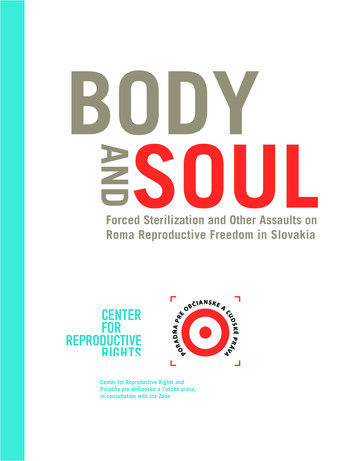
Transcription
ANDBODYSOULForced Sterilization and Other Assaults onRoma Reproductive Freedom in SlovakiaCenter for Reproductive Rights andPoradna pre obcianske a l’udské práva,in consultation with Ina Zoon
2Body and Soul 2003 The Center for Reproductive Rights and Poradπa pre ob ianskea udské práva (Centre for Civil and Human Rights or Poradπa). Anypart of this report may be copied, translated or adapted with permissionfrom the authors, provided that the parts copied are distributed free orat cost (not for profit) and the Center for Reproductive Rights andPoradπa are acknowledged as the authors. Any commercial reproduction requires prior written permission from the Center or Poradπa. TheCenter for Reproductive Rights would appreciate receiving a copy of anymaterials in which information from this report is used.ISBN 1-890671-28-2
Roma Reproductive Freedom in Slovakia 3Table of ContentsACKNOWLEDGEMENTS5TABLE OF ABBREVIATIONS AND GLOSSARY7EXECUTIVE Y33BACKGROUND37General37Situation of Roma38History of Coerced and Forced Sterilization41Medical Aspects of Caesarian Delivery and Female Sterilization48TESTIMONIESCoerced, Forced and Suspected Sterilization5355Abuse and Discrimination in Maternity Wards74Denial of Access to Medical Records90LEGAL STANDARDSCONCLUSION95119
4Body and Soul
Roma Reproductive Freedom in Slovakia 5AcknowledgementsWe are grateful to the Romani and non-Romani women in eastern Slovakia whoagreed to be interviewed for this report. Without their cooperation and trust, thisreport would never have been possible.The Center for Reproductive Rights and Poradπa pre ob ianske a udské práva(Centre for Civil and Human Rights or Poradπa) produced the report. It was written by Christina Zampas, legal adviser for Europe, and Sneha Barot, legal fellow inthe International Legal Program of the Center for Reproductive Rights, and byBarbora Bukovska, executive director of Poradπa, in association with Ina Zoon, anexpert consultant on minority rights issues.The report is based on fact-finding missions undertaken in eastern Slovakiabetween August and October 2002 by Ms. Bukovska, Vierka Kusendová of Poradπa,Ms. Zoon, Ms. Zampas, and Ms.Barot, jointly with the staff of Poradπa, includingLadislav Zamboj, Andrea Gruberová, Alena Svobodová, and Rastislav Hanulak. Inaddition, Dr. Timothy Holtz of Doctors for Global Health and Ruben Pellar, humanrights activist, participated in portions of the fact-finding.Several people at the Center for Reproductive Rights contributed to the realization of this report. Katherine Hall-Martinez, international program director, provided guidance, editing and input regarding the report’s structure and content.Ghazal Keshavarzian, Shannon Kowalski-Morton and Andrea Lipps, internationalprogram assistants, provided research, editing and administrative support throughoutthe drafting and finalizing of the report as well as support during the productionprocess. Preliminary research and other assistance was provided by Pardiss Kebriaeiand Clara Padilla, international legal fellows, and Zahra Ahmed, Julie Greenspoon,Rosy Kalfus, Monika Ladmanová, Eszter Kismodi, and Katrine Thomasen, formerinternational program interns.We are also grateful to members of the Communications Department at theCenter for Reproductive Rights, who offered guidance and input on variousaspects of the report. Anaga Dalal, managing editor, reviewed several drafts, edited the text and provided input. Deborah Dudley art directed design and cover.Jonathan Weiss, production associate, worked on layout production and created
6Body and Soulthe necessary Slavic typography.We are indebted to many people inside and outside of Slovakia who were particularly generous with their time and provided invaluable information. While thereare too many to name here, we are particularly grateful to the following (in alphabetical order):Claude Cahn, European Roma Rights Center; Kveta onková, RomaCommunity Centre Future (Vranov nad Top ou); Agnes Darócozi; Dr. ChuckDeProsse, retired professor of obstetrics and gynecology, University of Iowa; ErikaGodlová, Association of Roma Women (Pre ov); Dr. Timothy Holtz, Doctors forGlobal Health; Anna Koptová, Foundation of Good Roma Fairy Kesaj (Ko ice);Edmund Mûller, Centre for Roma Rights (Ko ice); Dimitrina Petrova, EuropeanRoma Rights Center; Amália Pompová, Association of Roma Citizens ZOR(KeΩmarok); and Professor Judit Sándor, Central European University.
Roma Reproductive Freedom in Slovakia 7Table of Abbreviations and GlossaryABBREVIATIONCOMPLETE TERM AND DEFINITIONBeijing Conference1995 United Nations Fourth World Conference onWomen: Global conference on women’s humanrightsBeijing Platform for ActionBeijing Declaration and Platform for Action, UnitedNations Fourth World Conference on Women:Consensus document adopted by nationsparticipating in the Beijing ConferenceCEDAWConvention on the Elimination of All Forms ofDiscrimination against Women: International treatycodifying states’ duties to eliminate discriminationagainst womenCEDAW CommitteeCommittee on the Elimination of Discriminationagainst Women: UN body charged with monitoringstates’ implementation of CEDAWCERDCommittee on the Elimination of RacialDiscrimination: UN body charged with monitoringstates’ implementation of the Racial DiscriminationConventionCharter of Fundamental RightsCharter of Fundamental Rights of the EuropeanUnion: European Union charter upholding the civil,political, economic, and social rights of Europeancitizens and all persons residing in the EU
8Body and SoulCivil and Political Rights CovenantInternational Covenant on Civil andPolitical Rights: International treatyprotecting individuals’ civil and politicalhuman rightsConvention against Racial DiscriminationInternational Convention on theElimination of All Forms of RacialDiscrimination: International treatyupholding individuals’ human rights to befree of discrimination on the basis of raceConvention against TortureConvention against Torture and OtherCruel, Inhuman or Degrading Treatmentor Punishment: UN treaty upholdingindividuals’ rights to be free from tortureand other forms of crueltyCouncil on EuropeCouncil on Europe: Regionalintergovernmental body consisting of 44European member states dedicated topromoting human rights and fundamentalfreedoms of European citizens and residentsDeclaration on Violence against WomenDeclaration on the Elimination of Violenceagainst Women: International agreementprotecting women’s right to be free ofviolenceEconomic, Social and CulturalInternational Covenant on Economic,Rights CovenantSocial and Cultural Rights: Internationaltreaty protecting individuals’ economic,social and cultural human rights
Roma Reproductive Freedom in Slovakia 9EUEuropean Union: Regionalintergovernmental body consisting of 15Member States and 10 CandidateCountries dedicated to promotingEuropean integrationEuropean Convention Against TortureEuropean Convention of the Prevention ofTorture and Inhuman or DegradingTreatment or Punishment: Europeantreaty upholding individuals’ rights to befree from tortureEuropean Convention on Human RightsEuropean Convention on Human Rightsand Fundamental Freedoms: Europeantreaty upholding the rights of theUniversal DeclarationEuropean Convention on Human RightsConvention for the Protection of Humanand BiomedicineRights and Dignity of the Human Beingwith Regard to the Application ofMedicine: European treaty safeguardinghuman dignity and the fundamental rightsand freedoms of the individual with regardto the application of biology and medicineFIGOInternational Federation of Gynecologyand ObstetricsFramework Convention for MinoritiesFramework Convention for the Protectionof National Minorities: European treatyupholding the protection of the rights ofnational minorities
10Body and SoulGenocide ConventionConvention on the Prevention andPunishment of the Crime of Genocide:UN treaty upholding individuals’ rights tobe free from genocideHuman Rights CommitteeHuman Rights Committee: TreatyMonitoring Body charged with monitoringstates parties’ compliance with the Civiland Political Rights CovenantICPDInternational Conference on Populationand Development: United NationsConference on population anddevelopment held in Cairo in 1994.ICPD Programme of ActionProgramme of Action of the InternationalConference on Population andDevelopment: Consensus documentadopted by nations participating in theInternational Conference on Populationand DevelopmentIUDIntrauterine DeviceNGONon-governmental organizationOSCEOrganization of Security and Cooperationin Europe: Regional intergovernmentalorganization with 55 participating statesfrom Europe, Central Asia and NorthAmerica active on a range of securityrelated issues including human rights
Roma Reproductive Freedom in Slovakia 11Race DirectiveCouncil of the European Union Directive2000/43/ECRome Statute of the ICCRome Statute of the InternationalCriminal Court: UN treaty establishing aglobal criminal tribunal devoted to crimesof genocide, war crimes and crimesagainst humanitySKKSlovak Crowns: Unit of currency forSlovakiaUniversal DeclarationUniversal Declaration of Human Rights:UN human rights instrument at thefoundation of modern internationalhuman rights lawWCARWorld Conference against Racism, RacialDiscrimination, Xenophobia and RelatedIntoleranceWHOWorld Health Organization: UN agencydevoted to researching and promotingpublic health worldwideWHO Declaration on Patients’ RightsA Declaration on the Promotion of Patients’Rights in Europe: WHO sponsoreddocument defining principles andstrategies for the promotion of patients’rights
12Body and Soul
Roma Reproductive Freedom in Slovakia 13Executive SummaryIn late 2002, the Center for Reproductive Rights in collaboration with Poradπa preob ianske a udské práva (Centre for Civil and Human Rights, hereinafterPoradπa), a Slovak human rights organization, and Ina Zoon, an expert consultanton minority rights issues, conducted a human rights fact-finding mission involvingin-depth, private interviews with more than 230 women in almost 40 Romani settlements throughout eastern Slovakia, the region with the highest concentration ofRoma, on topics including sterilization practices, treatment by health-care professionals in maternal health-care facilities and access to reproductive health-care information. We also interviewed Slovak hospital directors, doctors, nurses, patients, government officials, activists, and non-governmental organizations regarding thesesame issues. Our research has uncovered widespread violations of Romani women’shuman rights, specifically reproductive rights, in eastern Slovakia that include thefollowing: coerced and forced sterilization;1 misinformation in reproductive health matters; racially discriminatory access to health-care resources and treatment; physical and verbal abuse by medical providers; and denial of access to medical records.Slovakia is scheduled to become a member state of the European Union (EU)in 2004. This membership confers economic benefits as well as political and socialresponsibilities on members in accordance with the aquis, the EU’s legal framework.Overshadowing this historic moment, however, is the Slovak government’s continued denial of the human rights of minority Romani women.Discrimination against the Roma is historically based, stretching back severalcenturies. In modern times, persecution of the Roma was enforced under the Naziregime through, among other things, a policy of forced sterilization. This practicewas continued during communist times in Czechoslovakia, when Romani womenwere specifically targeted for sterilization through government laws and programs
14Body and Soulthat provided monetary incentives and condoned misinformation and coercion.The Slovak government claims these programs were dismantled following the fall ofcommunism in 1989. However, our fact-finding reveals that serious human rightsviolations continue despite the official change in the most obviously problematiclaw. Indeed, our fact-finding clearly indicates that discrimination against Romaniwomen remains deeply and disturbingly entrenched in Slovak society. Governmentofficials and health-care providers today openly condone attitudes and practices thatviolate the bodily integrity, health rights and human dignity of Romani women inneed of reproductive health-care services. Romani women are particularly vulnerable to multiple forms of discrimination because they bear the double burden of bothrace and gender stereotypesFindingsCoerced and Forced SterilizationSlovak health-care providers throughout eastern Slovakia are complicit in the illegaland unethical practice of sterilizing Romani women without obtaining theirinformed consent. Our fact-finding uncovered clear and consistent patterns ofhealth-care providers who disregarded the need for obtaining informed consent tosterilization and who failed to provide accurate and comprehensive reproductivehealth information to Romani patients, resulting in the violation of their humanrights. We held in-depth interviews with more than 140 women who were coercively or forcibly sterilized or have strong indications that they were forcibly sterilized.Approximately 110 of these women have been sterilized or have strong indicationsthat they have been sterilized since the fall of communism. The approximately 30remaining interviews in this category were with women who were sterilized duringthe communist regime’s practice of providing monetary incentives for women toundergo sterilization. This report focuses on our findings of coerced and forced sterilization practices since the fall of communism.In many of these cases, doctors and nurses furnished misleading or threateninginformation to Romani women in order to coerce them into providing last-minuteauthorizations for sterilizations that were performed when women were undergoinga cesarean delivery. These medical practitioners appeared to unnecessarily and irre-
Roma Reproductive Freedom in Slovakia 15sponsibly perform C-sections on Romani women at least in part as a pretext for sterilizing them. After two or three cesarean births, doctors told Romani women thatthey needed to be sterilized because another pregnancy will result in either the deathof their baby or themselves. Health-care personnel used misleading medical premises, such as ‘repeat cesareans are fatal,’ to justify sterilizations. Neither accurate information on the actual risks of future pregnancies nor other options, such as alternative contraceptive methods, were discussed. As a result, threatening and medicallyinaccurate statements allowed doctors to scare women into succumbing to medically unnecessary sterilizations in the midst of childbirth.In other cases, Romani women were given no information about sterilizationprocedures nor were they informed that they would be sterilized prior to undergoingthe procedure. In these instances, doctors or nurses obtained authorization papersfrom Romani women after the fact or simply notified them of the procedure once ithad been completed. In a few cases, women under the age of 18 were forcibly sterilized without the authorization required by law from their legal guardians. Manyother women were never even told that they had been sterilized, leaving them to simply suspect an unwanted gynecological intervention. It sometimes took thesewomen years, if ever, to confirm that they had been sterilized.In sum, the fact-finding demonstrates that Slovak doctors are consistentlyderelict in their duty to provide Romani women with information about their reproductive health status and options. These doctors instead choose to make intimatehealth decisions for women without supplying them with the information they needand are entitled to as the primary decision-makers over their bodies and future reproductive capacity.Discriminatory Standards of CareOur investigation of the services and care provided to Romani women in maternitywards and gynecology departments of many hospitals in eastern Slovakia disclosespatterns of systematic and glaring racial discrimination, including segregation.Romani women are placed in separate rooms from white women and are often prohibited from using the same toilets and dining facilities as their white counterparts.Their requests to be moved to integrated rooms are ignored or met with insults fromdoctors and nurses. Romani women are also provided substandard treatment or
16Body and Soulsometimes are denied treatment altogether. Some doctors have limited office hoursfor Romani women or force them to wait for urgent services until all white womenhave been examined. Ambulances from certain hospitals in eastern Slovakia eitherrefuse or delay services for pregnant women in Romani settlements, even when thewoman is about to deliver. Corruption is endemic among health-care personnel,who request payment from women for services that are covered by health insuranceor provide low-quality treatment when they feel the bribe is insufficient. Romaniwomen, who are often singled out due to racial hostility and who may be less able toafford bribes because of their lower economic status, feel this corruption more acutely.Physical and Verbal AbusePhysical and verbal abuse driven by racial hatred taints the Slovak health-care system, undermining trust in health-care personnel and creating an atmosphere of fearand anxiety among Romani patients. Interviews with Romani women accessingmaternal health services in eastern Slovak hospitals unveiled accounts of devastatingencounters with doctors and nurses who beat, insult, humiliate, and neglect theirRomani patients. Hospital administrators, doctors and nurses openly express racistviews to their Romani patients, whom they regard as morally defective, unable toprovide for their children and unworthy of medical services. Many health-care workers complain about the fertility rates of Romani women and see these birth rates asa direct threat to Slovakia. These stereotypes inform the behavior of health-care personnel toward Romani patients, who in turn suffer from poor reproductive healthcare and increased marginalization, with negative repercussions on the overallhealth status of Romani women.Denial of Access to Medical RecordsDuring the course of our fact-finding, we uncovered repeated violations of patients’legal right to access their medical records. When our research team, with thewomen present or with a power-of-attorney, attempted to access Romani women’smedical records, to further our investigation of forced sterilization practices, hospital authorities impeded these efforts. Though Slovak law guarantees individuals theright to view their medical records, Romani patients are arbitrarily and unjustlydenied this right and are also not allowed to learn about the medical procedures per-
Roma Reproductive Freedom in Slovakia 17formed on them. Appointed and qualified legal counsel for Romani patients are alsonot permitted to view medical records on behalf of their Romani clients. Thisobstruction of access prevents Romani women who suspect that they have been sterilized from obtaining confirmation through their medical records.There are no clear government regulations or hospital rules on ensuringpatients access to their medical records. Implementation of the law is left to the discretion of the director and doctors of individual hospitals. Because it is extremelyrare for Slovak patients to request their medical records, doctors often feel threatenedby these requests and instinctively block access with nearly complete impunity.Moreover, the Ministry of Health, the government body that regulates health-careservices, has not only failed to instruct hospitals to provide access to medical records,but in several cases has effectively supported officials in eastern Slovak hospitals whodenied women access to their records in cases of suspected sterilization. Limitingaccess to medical records denies Romani women any opportunity to challenge possible violations, seek vindication of their rights in Slovak courts or obtain legal remedies for violations of their rights within the health-care system.Government ComplicityThe Slovak government has a duty to promote, protect and fulfill the human rightsof all its citizens, including, and especially, the minority Romani population. Theimportance of this duty is heightened as coerced and forced sterilizations and otherhuman rights abuses are occurring in publicly funded hospitals by government personnel. Despite the mounting evidence of human rights abuses against Romaniwomen throughout the decade following the fall of communism, government officials in Slovakia have failed to condemn and put an end to these practices. Anddespite several coerced and forced sterilization complaints filed in Slovak courts andwith Slovak law enforcement, health-care workers have yet to be sanctioned for theirdiscriminatory and abusive treatment of Romani women. The Ministries of Healthand Justice and the Office for Human Rights, Minorities and Regional Developmenthave also failed to document and investigate reproductive rights violations, sanctionthose responsible or adopt policies designed to curb the practices that help perpetuate these abuses. Instead, the Slovak government and hospital administrators dismissevidence of discriminatory treatment as either inconsequential or untrue. Other dis-
18Body and Soulcriminatory practices are defended as necessary for medical and social reasons. Suchrationalizations misrepresent or conceal insidious practices and attitudes that arecontrary to fundamental human rights principles and can only lead to destructiveresults for a newly democratic society.Transition to a Democratic and Just SocietyAs the countries of Eastern and Central Europe transition into market economies andintegrate into the European Union, their commitments to and obligations underinternational and regional law and policy must be demonstrated and, where necessary, strengthened. Indeed, the EU requires stable democratic institutions, the ruleof law, human rights, and respect for minorities as prerequisites for membership.However, the region’s treatment of its minority Roma population is testing these standards. The situation of Roma in eastern Slovakia is among the worst in all of Europe.Though the country has one of the largest populations of Roma in the region, theyhave an abysmal standard of living in all areas of Slovakia. They face discriminationin accessing health care, housing, education, the criminal justice system, and socialassistance. Romani women are further marginalized through the double burden ofboth gender and race discrimination. The confluence of these prejudices is apparentin the egregious reproductive rights violations Romani women suffer, includingcoerced and forced sterilization and other severe forms of discrimination in accessingreproductive health care. This treatment is in contravention of fundamental humanrights standards supported by international and regional law. As Slovakia seeks membership to the European Union, which requires a commitment to human rights, it hasa duty to investigate and end the violations committed within its borders.
Roma Reproductive Freedom in Slovakia 19RecommendationsThe human rights violations documented in this report are directly attributable tothe actions of Slovak government employees and officials, as well as officials’ failureto investigate and punish those responsible for violations. Thus, primary responsibility for their redress lies with the government. The recommendations below highlight specific actions that the government should take immediately to remedy pastviolations and deter future ones. The violence and discrimination to which Romaniwomen have been subjected in the context of maternal health services in easternSlovakia is not the only arena of severe violations against the Slovak Roma. Indeed,the magnitude of discrimination against the Roma in all aspects of life is shocking.It will require concerted and long-term government action to end this discriminationby both governmental and private entities. But addressing coerced and forced sterilization cuts to the very heart of the challenge the Slovak government must meet ifit is to become a member of the European community of nations devoted to equality and the rule of law.The recommendations below include measures to address the severe violationsto the bodily integrity, freedom and autonomy of Romani women inherent incoerced and forced sterilization. They also include recommendations related tolegal reform, programmatic responses, and improved enforcement of existing domestic legal rights and protections to address Romani women’s rights to accurate andcomprehensive health information, non-discrimination in health services, andunimpeded access to medical records. Finally, they include recommendations tothe European Union, the Council of Europe, and the United Nations to investigateand pressure Slovakia to appropriately redress violations of Romani women’s reproductive rights, in light of their mandate under the applicable European and international instruments to which Slovakia is legally bound.TO THE GOVERNMENT OF SLOVAKIA: Create a new independent body or assign an existing governmental body to examine all allegations and complaints of coerced and forced sterilization. The body
20Body and Soulshould be empowered to issue findings of fact and to order remedial measures for victims and should include independent, highly qualified members of civil society andmembers of the Romani community. Its processes should be transparent, its findingsshould be publicized, and annual reports of its activities and findings should be published. The body should publicly condemn coerced and forced sterilization, both inthe communist and post-communist periods. The body should be empowered to: Investigate individual complaints on an ongoing basis. The body’s roleshould be publicized and details of its existence and procedures be madereadily accessible to the Romani community, taking into account the geographical remoteness of some Romani settlements as well as the culturaland language barriers faced by the Romani population. In cases where awoman suspects that she was sterilized without her knowledge, medicalrecords should be reviewed and appropriate medical examinations shouldbe carried out to ascertain whether she was in fact sterilized. Conduct fact-finding missions to ascertain the full extent of coerced orforced sterilization in the post-communist period. Gather statistics and examine all other relevant information to ascertain the prevalence of sterilizationin the Romani population. Investigate sterilization policies under communism. Examine the archivesof the relevant governmental entities to ascertain the extent to which theRomani population was a target of sterilization policies. An analysis of thenumber of Romani women who were sterilized both before and after themonetary grant was introduced, should also be conducted. Provide remedial measures and award monetary damages to women whowere sterilized coercively or forcibly. The body should establish reasonableevidentiary standards to determine whether coerced or forced sterilizationoccurred, as well as procedures to fairly determine physical, emotional andmoral damages. Available remedies should include the provision of accu-
Roma Reproductive Freedom in Slovakia 21rate medical information about procedures to reverse sterilization andensuring that those women who want more children have access to suchprocedures where medically advisable. Recommend to the Ministry of Justice criminal prosecution for all medicalprofessionals implicated in coerced and forced sterilizations. Ensure thatmedical professionals who are not held criminally responsible are referredto their professional associations for appropriate professional sanction. Ifinvestigations reveal policies or practices intended to reduce the Romanipopulation, those responsible should be prosecuted under the relevantnational and international law governing genocide. In any criminal proceedings, the findings of the body should be deemed admissible evidence. Create a Ministry of Women’s Affairs whose mandate is to promote and protectwomen’s equality in the social, economic and political spheres, with an emphasison fully ensuring women’s human rights, including the rights of minority women.To the National Council (Parliament): Ratify Additional Protocol No. 12 to the European Convention for the Protectionof Human Rights and Fundamental Freedoms, which prohibits discrimination onany grounds. Adopt anti-discrimination legislation that comports with the principles establishedin the EU Race Directive. Special attention should be paid to the establishment ofa body with competence to analyze the problems of discrimination, to study possible solutions and to provide concrete assistance for the victims. This body shouldalso be mandated to systematically monitor, investigate and sanction cases of abuseand discrimination in health-care services. Allocate more budgetary resources to addressing discrimination against the Romain all relevant ministries and offices.
22Body and SoulTo the Ministry of Justice and Law Enforcement Officials: Ensure the safety of Romani women and their families who were or are suspected ofhaving been interviewed for this report. It is of grave concern that Romani womenor the settlements that they belong to will face the brunt of any backlash stemmingfrom this report. Given the record of violence and intimidation against Romanicommunities, Slovak government officials must take proactive steps to prevent anyforms of violence or retaliation against the Roma, particularly by health-careproviders on whom the Roma depend. Take measures to ensure all m
human rights, specifically reproductive rights, in eastern Slovakia that include the following: coerced and forced sterilization;1 misinformation in reproductive health matters; racially discriminatory access to health-care resources and treatment; physical and verbal abuse by medical providers; and










